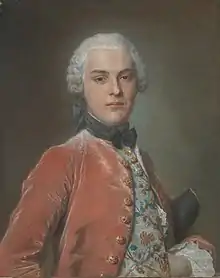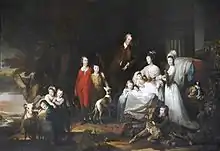Henry Dawkins
Henry Dawkins II (24 May 1728 – 1814) was a Jamaican plantation owner and Member of the Parliament of Great Britain (MP).
Henry Dawkins | |
|---|---|
 | |
| Born | 24 May 1728 |
| Died | 1814 |
Background
The Dawkins family settled on Jamaica shortly after its seizure from the Spanish in 1655. William Dawkins acquired plantations in Jamaica, by grant, in the period 1669 to 1682. These descended to his grandsons James Dawkins I, and the sons of Henry Dawkins I, James Dawkins II and Henry Dawkins II, sons of Henry Dawkins I, all three being MPs. Both James I and James II left property in England to Henry II, who also inherited Jamaican properties from relatives, for an annual income of £40,000 to £50,000.[1]
Life
He was born 24 May 1728 in Clarendon, Jamaica. He was the second surviving son of Henry Dawkins (1698–1744), a sugar planter, and his wife, Elizabeth, daughter of Edward Pennant of Clarendon, chief justice of Jamaica; James Dawkins II, who died in 1757, was his eldest brother. He studied at John Roysse's Free School in Abingdon, (now Abingdon School) c. 1739-1744 and St Mary Hall, Oxford from 1745.[2][3] Dawkins's father on his death in 1744 bequeathed 25,000 acres of land and approximately £100,000 to his three surviving sons. James, the eldest son (James Dawkins II, who died in 1757), inherited 14,300 acres, William received 5000, and Henry 5700.
From 1752 to 1758 Henry Dawkins was a member of the assembly in Jamaica, and was then on the council to 1759. In 1760 he entered the Parliament of Great Britain as member for Southampton, holding the seat to 1768. He then was member for Chippenham, Hindon and Chippenham again, leaving Parliament finally in 1784. He served for a 24-year period with only short breaks (one caused by his defeat at Salisbury, near his estate at Standlynch, in 1768). He was a Steward of the Old Abingdonian Club in 1769.[4]
According to the Oxford Dictionary of National Biography, there is no record of Dawkins having spoken in the House of Commons. However, from 1773 to 1805 he was a member of the Society of West India Planters and Merchants, a pressure group.
His son James succeeded him at Chippenham.[3]
He died in London and was buried at Chipping Norton.
Properties in England
Dawkins sold his brother's estate at Laverstoke in 1759.[5]
In 1766 he inherited Over Norton Park in Oxfordshire from his uncle James Dawkins. He kept this property (which remains in the Dawkins family to this day).
Standlynch House
Also in 1766 he bought Standlynch Park in Wiltshire. This house, now called Trafalgar Park, was bought from William Young, for £22,000.[6][7] When Dawkins died in 1814, Standlynch Park was sold for £90,000 to William Nelson, 1st Earl Nelson, who had been voted the money needed to purchase an estate by Parliament.[1] He changed the name to Trafalgar House and Park.[8]
Intellectual interests
Dawkins was a patron of neoclassical architects. He had alterations done to Standlynch House (a building by the architect John James dating from the 1730s).[9] Dawkins had work done on the wings, by John Wood, the Younger, and on the portico by Nicholas Revett. Revett was an associate of Dawkins' brother James, who had antiquarian interests. Revett and both Dawkins brothers were members of the Society of Dilettanti.[10]
He was elected a Fellow of the Royal Society in 1778.[11]
Family

Dawkins married in 1759, Lady Juliana Colyear, daughter of Charles Colyear, 2nd Earl of Portmore.[3] They had eight sons and four daughters. The sons were:[12]
- James, Member of Parliament, married in 1785 Hannah Phipps, and secondly Maria Forbes[13]
- George Hay, Member of Parliament, married in 1807 Sophia Mary Maude, daughter of Cornwallis Maude, 1st Viscount Hawarden, and in 1814 Elizabeth, daughter of William Henry Bouverie[14]
- Henry (1765–1852), Member of Parliament for Boroughbridge, married in 1788 Augusta, daughter of Sir Henry Clinton, father of Henry Dawkins, also Member of Parliament for Boroughbridge[15]
- William, died an infant
- Richard, married Jane Catherine Long, daughter of Edward Long and Elizabeth Masters. Father of James Dawkins I
- Edward, who took holy orders
- Charles, in the Grenadier Guards
- John (1774–1844), Fellow of All Souls College, Oxford and barrister[16]
The daughters were:[12]
- Augusta, died an infant
- Elizabeth, married in 1795 William Ronke Leeds Sergeantson[17] or William Rookes Leedes Serjeantson[18]
- Juliana, died unmarried in 1847
- Susanna, married in 1804 Sir Edward Dodsworth, 2nd Baronet.[19]
Henry was the great-great-great-grandfather of the famous biologist Professor Richard Dawkins. In 2010 Richard Dawkins wrote an obituary for his father, describing how John Dawkins had inherited Over Norton Park from a distant cousin and how the estate, in the Cotswolds Area of Outstanding Natural Beauty, had been in the family since the 1720s.[20]
See also
Notes
- H. J. Habakkuk (1994). Marriage, Debt, and the Estates System: English Landownership, 1650–1950. Clarendon Press. pp. 455–6. ISBN 978-0-19-820398-8.
- Parker, M. St John. "Dawkins, James". Oxford Dictionary of National Biography (online ed.). Oxford University Press. doi:10.1093/ref:odnb/7338. (Subscription or UK public library membership required.)
- "Dawkins, Henry (1728–1814), of Over Norton, Oxon. and Standlynch, Wilts., History of Parliament Online". Retrieved 10 June 2016.
- "Object 13: Stewards of the OA Club". Abingdon School.
- George Frederick Prosser (1833). Select Illustrations of Hampshire. J. & A. Arch. p. 154.
- "History of Trafalgar Park Wiltshire". Retrieved 10 June 2016.
- H. J. Habakkuk (1994). Marriage, Debt, and the Estates System: English Landownership, 1650–1950. Clarendon Press. p. 456. ISBN 978-0-19-820398-8.
- Pocock, Tom. "Nelson, William". Oxford Dictionary of National Biography (online ed.). Oxford University Press. doi:10.1093/ref:odnb/19888. (Subscription or UK public library membership required.)
- Christopher Christie (2000). The British Country House in the Eighteenth Century. Manchester University Press. pp. 47–. ISBN 978-0-7190-4725-1.
- Nikolaus Pevsner; Bridget Cherry (1975). Wiltshire. Yale University Press. p. 529. ISBN 978-0-300-09659-0.
- Thomas Thomson (1812). History of the Royal Society, from Its Institution to the End of the 18th Century. Baldwin. p. lvii.
- Sir Bernard Burke (1871). A Genealogical and Heraldic History of the Landed Gentry of Great Britain & Ireland. Harrison. p. 334.
- "Dawkins, James (1760–1843), of Standlynch, Wilts., History of Parliament Online". Retrieved 10 June 2016.
- "Dawkins Pennant, George Hay (1764–1840), of Penrhyn Castle, Caern., History of Parliament Online". Retrieved 10 June 2016.
- "Dawkins, Henry (1765–1852), of Over Norton, Oxon., History of Parliament Online". Retrieved 10 June 2016.
- "John Dawkins (1774–1844), Summary of Individual, Legacies of British Slave-ownership". Retrieved 10 June 2016.
- The Lady's Magazine Or Entertaining Companion for the Fair Sex: Appropriated Solely to Their Use and Amusement. Baldwin, Cradock & Joy. 1795. p. 296.
- E. Walford (1882). The county families of the United Kingdom. Рипол Классик. p. 576. ISBN 978-5-87194-361-8.
- John Burke (1833). A General and Heraldic Dictionary of the Peerage and Baronetage of the British Empire. H. Colburn. p. 369.
- "Slaves at the root of the fortune that created Richard Dawkins' family estate". The Daily Telegraph.